Human have been aware of the sun since ancient times. The primitive human beings have seen that the sun rises daily in the morning and goes away in the evening. The primitive human beings should have even anticipated that if the Sun does not grow then black will become dark and every thing will become black and cold and it will end human life. Therefore, people of ancient times gave the status of the deity to the sun and started worshiping it.
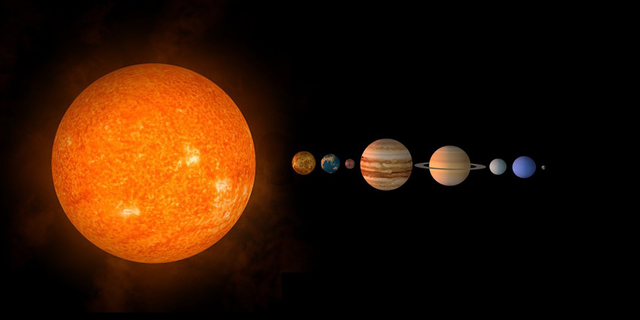
Image Credit
Today we know that the sun is a very important star, but it is a very important relationship with daily life. At present, in the eyes of the public, Sun is a huge shell of intense fire stained in the sky, it is a symbol of faith. Often people will have to raise questions in such a way that what are the fuels which are always burning inside this sphere? How about its furnace? How far is this ball from us? Why do Sun-eclipse occur? What is the structure of the sun? Why do these eight planets revolve around the sun? Is Sun also born? If it is born, will it even die?
Science students also have such intriguing questions, but in some scientific terms, how much is its diameter? What is the temperature of its surface? How are its compositions? What are solar flames? What are solar-stigma? Is there any direct or indirect relation with its energy of nuclear power? Does the sun have any special place in our galaxy?
We know that there is no end to human curiosity. Humans have always been trying to get answers to the above questions related to the sun. The result of this is that today we have accurate answers to all these questions available. Let us try to know the answers of these questions from the perspective of modern science.
Generally, if any person is asked the question that he is the closest to us then he starts speculation. When the curtains of the sun rise, it turns out that the Sun is a common star among nearly 200 billion stars present in our galaxy. Although the Sun appears to be more luminous than other stars because it is closer to the Earth than other stars. But its proximity makes it the most important star.
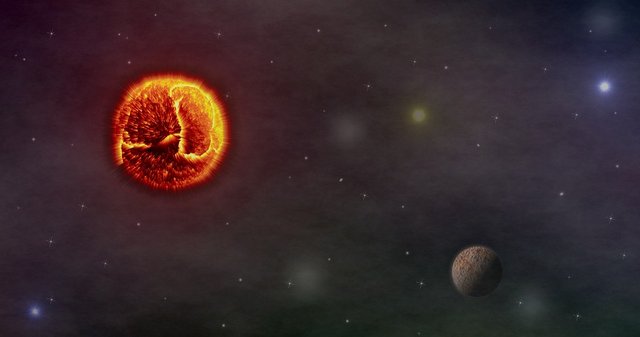
Image credit
If the sun is the nearest star to us, then how far is it from us? Sun is about 14,95,98,000 km away from the Earth (This is the reason that the most powerful binoculars on Earth have not even seen any other star surface than Sun) For astrophysicists this mean distance of Sun and Earth has special significance. Scientists named this distance as the 'celestial unit' or 'celestial unit'. With the help of 'astronomical unit', scientists deduce the distances from other planets in the solar system by assuming the distance of the sun to 1. You would have thought that if our nearest star is so far away then how many stars will be away from us? If we start removing the rest of the remaining kilometers in kilometers, then what will not happen? So scientists had to set a special scale-light year In fact, the rays of light span about three lakh kilometers in a second. The distance covered by this velocity, in a year, is called a light-year. Therefore, a light-year is equivalent to 94 trillion, 60 billion, 52 crores, 84 lacs, 5 thousand kilometers. The nearest star to the Sun after us is the Proxima-Santauri, which is approximately 4.3 light-years away.
Light-year gives us both time and distance, we can also say that Proxima-Centauri will take 4.3 light-years to reach the light from the Earth. The brightest star in the sky, the plummet or beggar is about 9 light-years away from us. Another scale is used to measure distances of stars, which is called parsec. A parsec is equal to 3.26 light-years. Sun is about 8 minutes and 18 light seconds away from us. As we know that the Sun is the closest star to us and it is not yet possible to observe the surface of any other star, therefore, the scientists, by observing the surface properties of the sun, available elements, mass, etc. Integrated counterparts (models) have been created.
How big is Sun from the Earth?
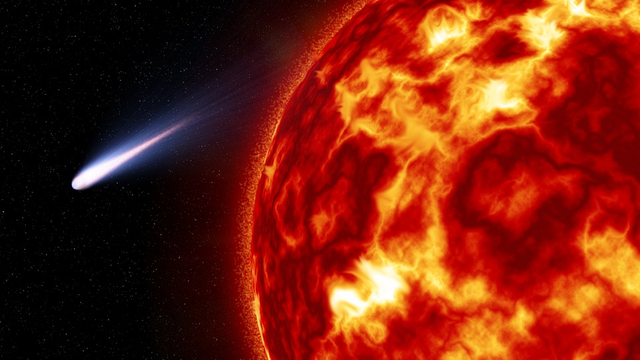
Image credit
In order to know how big the Sun is from our Earth, it is necessary to first understand the shape-type of our own earth. The diameter of our earth is approximately 12,700 kilometers. Sun is about 109 times bigger than our planet. That is, the radius of the sun is about 109 times more than the radius of the Earth. Actually, any body in the radius tells us how much mass in that body will occupy, that is, the volume of that object. Since the diameter of the Earth is 12,700 kilometers; Hence its radius is approximately 6,350 kilometers and the radius of the sun is approximately 109 times higher than the radius of the Earth, so the radius of the Sun is approximately 6,350 × 109 = 6,92,150 kilometers. So the sun is so big that it can contain approximately 13,00,000 celestial bodies like our Earth. This fact demonstrates the vastness of the sun in our horoscope.
You might be thinking that if there are 13,00,000 incompatible inside the Sun, then it should be 13 lakh times heavier than ours, but it is not so. The reasons are clear; We know that all stars are intense balls of gases. Since our sun is also a star, it is also a huge and intense circle of gases. It is not as solid as our earth and other planets. Here are the reasons that the density of the mass of the Sun is very less compared to the mass of the Earth. If we remove the density of the water by assuming the density of water as 1 and the density of the Sun's mass is about 1.4. And the mass of the Earth's mass will be 5.5 on average. Because there is too much gravitational pressure inside the Sun, hence the heat and pressure and density of the sun's center part are greatly increased. Estimates of Sun's mass are 1.981 × 10 ^ 30 kilograms, which are 3,32,900 times more than the mass of our Earth. You must be thinking that when a scientist can not go to the surface of the sun, and there can not be any robot or space, then how can we calculate the mass of the sun? Actually the mass of the Sun can be easily detected with the help of astronomical parameters and observations. From the orbital velocity of the planets, the mass of the Sun can be easily understood by mathematical methods.
As we know, there are 8 planets in our solar system, 166 satellites, some dwarf planets, thousands of asteroids, many comets and many meteorites. You must be thinking that if all these things are added to the world, then the sun's dwarfness will be negligible in front of them. But, the interesting fact is that on average, 99.89% of the entire solar system is surrounded by the Sun itself alone.
The Sun completes one revolution in 25.6 days on its axis. We know that this is not a solid body, but an intense tablet of gas. Therefore its various parts are rotated at different speeds. The speed of its velocity is 33.5 days on its poles. However, along with the orbiting the Sun, due to our changing position relative to the Earth, the speed of the sun moving around its equator is about 28 days.
Sunspot
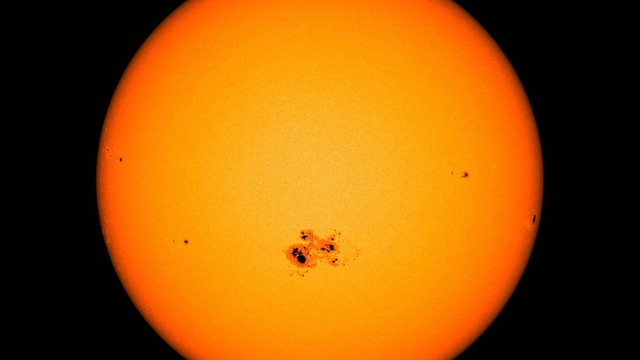
Image credit
Inspecting the sun with the help of solar filters, many black spots appear on its surface, which are called solar-stigma. Changes in size and number of these stigmas continue to change year after year. Activation increases in every 11 years in solar-stigmas. Therefore, the number of solar-stigmas decreases in the intervals of every eleven years. The last activity of solar-stigma was last seen in 2012. The scientists, however, still can not understand the good about the solar panels. Still we have some information about it. Indeed, many people think that this area of the Sun is very cold, but there is no such thing, the temperature of Dravyarashi of these stigmas is a little less than the other dwarf rats nearby. And due to the low temperature, these stigma appears to be black. With the help of solar-filters, these stigmas can be observed and studied daily, provided that the readers use good filters and never see the sun straight and naked.
Sun: An ideal star of the galaxy
When we look at the sky full of stars in the night, we get excited by the splendor of its splendor. If we live in a village, then we get more happiness, because more light than the cities, the brightness of the light of the lights is less and the environment is clean and peaceful.
When we observe the sky every day, we gradually find out that neither the light of all stars is the same, nor the color of them. All the stars and star clusters we can see with our naked eyes are all members of a very comprehensive plan, which appears to be in the sky almost equal to the river stretching from north to south. Call it 'galaxy' or 'galaxy'.
If we define the galaxy in the scientific language, then we can say that it is a group of stars that are bound together by one another because of their gravity. Ancient astrologers only considered the white stripes visible in the sky only as a galaxy. But today we know that in addition to billions of stars (most of which do not show with the naked eyes), our Earth, Moon, all other planets, the moon (natural satellite) of all the planets, meteoroid and All other members of the solar system are involved. Because of this vastness of the galaxy, it also says 'peninsular universes'.
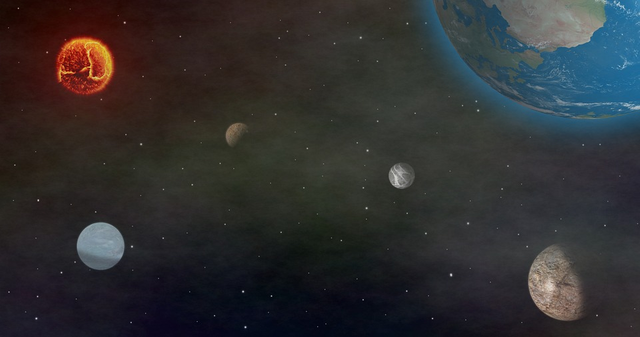
Image credit
There are millions of galaxies in the universe in our universe. In each galaxy, there is also a large cloud of gases and dust in addition to stars. These huge clouds are called nebula in star geology. 98% of the galaxy's total matter is made of stars and the remaining 2% is made of gas and dust clouds.
Our Sun and its family, ie the Solar System, whose name is a member of the galaxy, is called Milky way. You may have been thinking that every body in the sky is like a round or flat ball (Such beliefs are in the public domain), but it is not so. Imagine a flat roti to understand the size of the galaxy, whose middle is slightly floral. Together with billions of stars, a huge scheme is formed, which is called 'Mandakini'. In reality, the galaxy is a mandrakini itself.
The diameter of our galaxy is almost one million light years. And there are more than 100 billion stars in it; That is, its entire mass is equal to our 100 billion Suns. Our galaxy i.e. lactose is a member of a group of 24 galaxies called 'local groups'. Our Sun is about 30,000 light years away from the center of the galaxy. Sun is rotating in the center of the galaxy at a speed of 220 kilometers per second. Sun takes about 25 million years to complete a revolution of the galaxy. The interesting thing is that in the entire existence of man on Earth, the Sun has not completed even a single orbiter of the galaxy. And it is also clear, that the Sun is a normal star of the galaxy. But this does not indicate that the Sun is an ideal star.
Scientists have discovered some stars in the galaxy, which is hundreds of times larger than the sun. They are called 'Giant Star'. The diameter of these stars is 100 times more than our sun.
There are many such stars in the galaxy that are smaller than the sun-and many more stars are smaller than Earth and Mercury. Such stars are called 'white dwarf stars' or 'dwarf stars'. White Vamana stars are smaller than the Sun, but their mass is almost equal. The density of matter of Mahadanava stars is about one lakh times lower than the water density. Density of white wax wires or dwarf stars is very high. Their density can be ten million times more than the water density. One cubic centimeter of such stars can be more than 100 tons.
The stars whose density is more than one billion times the size of the water, such stars are called 'pulsars' or 'neutron' stars. Their diameter can be less than 40 kilometers. Hey! Pradip Bhaiya, even from them, it would not prove that the Sun is an ideal star. Indeed, the thing is that the sun is the main source of the energy of the organism on the earth. And most of the stars in the sun are in the middle class. Our sun is an ideal star because it is not such a star which can not be seen in the crowd, and there is no such thing which may surprise you. Understand That's why I used the title of an ideal star for the Sun in this episode.
The mystery of the sun's brightness
As we know, the sun is about 15 million kilometers away from us. We know that the sun is too close to us than the other stars, so we seem to be very powerful. Many intriguing questions arise in our minds related to the Sun-how does it shine? How does this generate so much energy? After all, what is the fuel inside the sun and the stars which is burning?
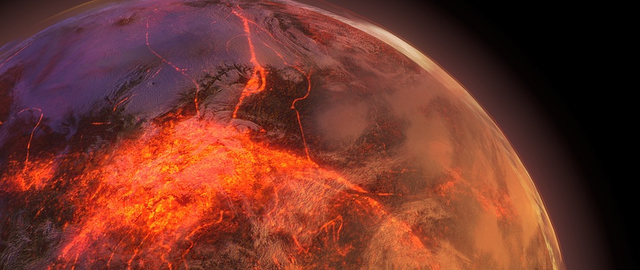
Image credit
Initially the combustion of oxygen and hydrogen was considered to be the source of the sun's energy. But if this happens then our sun could emit its energy only for two-three thousand years. In 1842, J. Mayer told that due to collapse of meteorites in the Sun, due to collision and abrasive, the resulting energy is emitting enough energy. But if this were to happen then the mass of the Sun would have increased dramatically and its effect should be deviation in the orbital velocity of the planets.
Due to lack of deviation in the velocity of the planets, Lord Kelvin and Herman Van Helmholtz explained the cause of energy in the sun as contraction. If we apply such a rule to the Sun, then we will get a wonderful result, that the sun has contracted in one point within half an hour. But we know that the Sun has been the same for thousands of years. Therefore, this hypothesis was also rejected.
Two scientist, Hauttermanns and Atkinson proposed that 'thermophilic reactions' were the source of energy in the Sun and other stars. In 1939, after two scientists, Weisjacker and Hans Bethe, independently researching this interpretation that hydrogen is combusted due to heat-related reactions in the Sun and other stars, changes in helium (fusion). Hydrogen is the highest concentration of sun and other stars, and it is also the highest amount in the universe. If we add four nuclei of hydrogen, then a helium nucleus is formed. Expecting the four nuclei of hydrogen, a helium nucleus has fewer mass. The famous equation of 'special relativity theory' E = mc², as laid down by Einstein in 1905 after all of these. Under this equation, mass is a form of energy, mass m is comparable to only E of energy.For the above thermal fusion, the reduction in helium mass will be returned in the form of energy. For this reason the sun and other stars shine.
But the fun fact is that not all stars spend their hydrogen in the same way. The stars that are larger than our sun are spending their hydrogen very fast. This means that the stars are as big as they spend hydrogen. The stars that are two times bigger than the sun are spending their own hydrogen ten times faster. The stars which are ten times bigger than the Sun, they are one thousand times faster. Such stars end up their hydrogen in very short time and reach the brink of death. The hydrogen that runs in the form of our Sun is running for a long time.
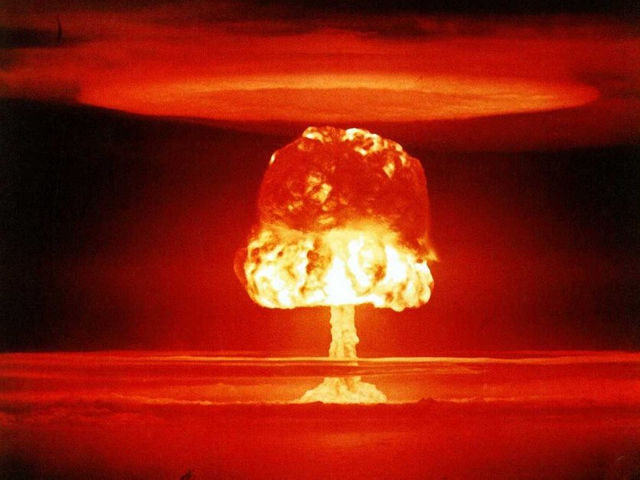
image credit
It is very important to know that the Earth has acquired knowledge of hydrogen bomb after 1950. Hydrogen bombs are not bigger in size. If so, you can hide the hydrogen bomb with a capacity of ten million TNT in a simple bed. The hydrogen bomb's trigger is usually equal to the capacity of atomic bombs. The energy generated by this bomb is actually the reason for thermophobia reactions. This implies that every day hundreds of thousands of hydrogen bombs break into the sun and other stars. But, the thermodynamic processes inside the stars are not in the form of explosive but in the balanced form. Earthlings have not been successful in fusion of fusion in a balanced way, if humans achieve success in making 'fusion furnace', then we will be able to create artificial wind turbines on earth. But the worrisome topic at this time is that the use of such devices as human hydrogen bombs has continued to be successful in the formation of destructive and destructive weapons and it has been very successful too. Fortunately, the hydrogen bomb has not been used in any war.

Sources used:
- The Facts About our Sun
- Astronomers discover the Sun’s core is rotating faster than the surface
- The Sun by the Atmospheric Imaging Assembly of NASA's Solar Dynamics Observatory
- Sunspot: Definition, Cycle & Theory
- Sun
Support @steemstem and the #steemstem project - curating and supporting
quality STEM related content on Steemit

This post has received a 0.95% upvote from thanks to: @marverick984.
thanks to: @marverick984.
For more information, click here!!!!
Send minimum 0.100 SBD to bid for votes.
Do you know, you can also earn daily passive income simply by delegating your Steem Power to @minnowhelper by clicking following links: 10SP, 100SP, 500SP, 1000SP or Another amount
Downvoting a post can decrease pending rewards and make it less visible. Common reasons:
Submit
very cool fact about sun......
Downvoting a post can decrease pending rewards and make it less visible. Common reasons:
Submit
Congratulations! This post has been awarded a 100% upvote by @lottobot! This post was the winner of lottery #1319, which had a total of 1 entries. @lottobot always has a lottery going on! If you would like to nominate a post for the current lottery, just send 0.1 SBD or STEEM to @lottobot, and include the url of the post you would like to nominate as a memo. Learn more by reading the introductory post! Good luck!
Downvoting a post can decrease pending rewards and make it less visible. Common reasons:
Submit